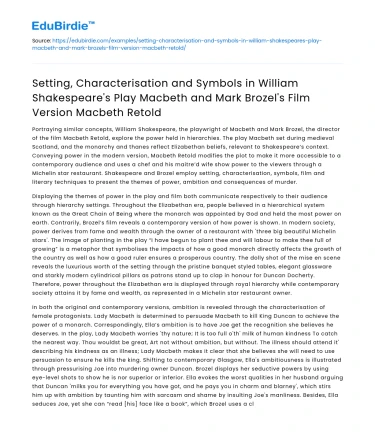Portraying similar concepts, William Shakespeare, the playwright of Macbeth and Mark Brozel, the director of the film Macbeth Retold, explore the power held in hierarchies. The play Macbeth set during medieval Scotland, and the monarchy and thanes reflect Elizabethan beliefs, relevant to Shakespeare’s context. Conveying power in the modern version, Macbeth Retold modifies the plot to make it more accessible to a contemporary audience and uses a chef and his maitre’d wife show power to the viewers through a Michelin star restaurant. Shakespeare and Brozel employ setting, characterisation, symbols, film and literary techniques to present the themes of power, ambition and consequences of murder.
Displaying the themes of power in the play and film both communicate respectively to their audience through hierarchy settings. Throughout the Elizabethan era, people believed in a hierarchical system known as the Great Chain of Being where the monarch was appointed by God and held the most power on earth. Contrarily, Brozel’s film reveals a contemporary version of how power is shown. In modern society, power derives from fame and wealth through the owner of a restaurant with 'three big beautiful Michelin stars'. The image of planting in the play “I have begun to plant thee and will labour to make thee full of growing” is a metaphor that symbolises the impacts of how a good monarch directly affects the growth of the country as well as how a good ruler ensures a prosperous country. The dolly shot of the mise en scene reveals the luxurious worth of the setting through the pristine banquet styled tables, elegant glassware and starkly modern cylindrical pillars as patrons stand up to clap in honour for Duncan Docherty. Therefore, power throughout the Elizabethan era is displayed through royal hierarchy while contemporary society attains it by fame and wealth, as represented in a Michelin star restaurant owner.
Save your time!
We can take care of your essay
- Proper editing and formatting
- Free revision, title page, and bibliography
- Flexible prices and money-back guarantee
In both the original and contemporary versions, ambition is revealed through the characterisation of female protagonists. Lady Macbeth is determined to persuade Macbeth to kill King Duncan to achieve the power of a monarch. Correspondingly, Ella’s ambition is to have Joe get the recognition she believes he deserves. In the play, Lady Macbeth worries 'thy nature; It is too full o'th' milk of human kindness To catch the nearest way. Thou wouldst be great, Art not without ambition, but without. The illness should attend it' describing his kindness as an illness; Lady Macbeth makes it clear that she believes she will need to use persuasion to ensure he kills the king. Shifting to contemporary Glasgow, Ella's ambitiousness is illustrated through pressurising Joe into murdering owner Duncan. Brozel displays her seductive powers by using eye-level shots to show he is nor superior or inferior. Ella evokes the worst qualities in her husband arguing that Duncan 'milks you for everything you have got, and he pays you in charm and blarney', which stirs him up with ambition by taunting him with sarcasm and shame by insulting Joe's manliness. Besides, Ella seduces Joe, yet she can “read [his] face like a book”, which Brozel uses a close up of Joe’s face flashed with blue light looking upon sharpened knives to define the determination in his eyes to kill Duncan to achieve his ambition of owning the restaurant which the blue symbolises aloofness coming ahead. Thus both Shakespeare and Brozel reveal how women ambitiously seek power though manipulating their husbands through.
The central protagonists' guilt is demonstrated through symbolism with blood and sleeplessness to showing the magnitude of their emotions. When Macbeth is visited by Banquo’s ghost; he states 'Blood will beget blood' reinforcing the tragic consequences that once the Macbeth’s have spilt blood through murder, more is inevitable. In comparison, Brozel portrays blood in a close up when Joe is drinking milk, and the milk turns into blood. Blood symbolises that after killing Duncan Docherty that his hands, like his guilt, can never be genuinely cleaned again. In a subsequent scene, Joe is framed dropping the milk bottle, which resembles dropping symbolising the demise of the milk of human kindness. Therefore, milk appears to emphasise Macbeth’s nature as well. Another symbol presented in the play is the idea of sleeplessness. When she is sleepwalking, Lady Macbeth rubs her hands together “Out, damned spot! Out, I say!” she laments about the amount of blood on her hands which connect to the idea of her torturous memories from the night she and her husband killed King Duncan. Likewise, the contemporary version shows sleeplessness through Ella continuously washing her hands through close-ups, ironically highlighting how “a little water and we are clean', now she will never be cleansed from this deed. Brozel operates a point of view shot to represent Joe's perspective, where Ella is visualised bathing in blood, illustrating how Joe and Ella are filthy with Duncan's blood. Guilt continues to plague both Macbeth and Joe as they come to see the ghost of their best friend whom they sanctioned to murder out of suspicion. Moreover, blood and visions symbolise to their audiences the guilt that the characters feel as a consequence of their horrific murders of those close to them. Therefore, both texts show that terrible actions come with demising consequences.
Both Shakespeare and Brozel explore the power held in hierarchies through setting, characterisation, symbols, film and literary techniques to present the themes of power, ambition and consequences of murder. At the end of the play and film, Lady Macbeth commits suicide, the central protagonist is killed without family or respective, and Malcolm restores the power. Both the playwright and director show that power influences greedy ambitions which leads to dire consequences.






 Stuck on your essay?
Stuck on your essay?

